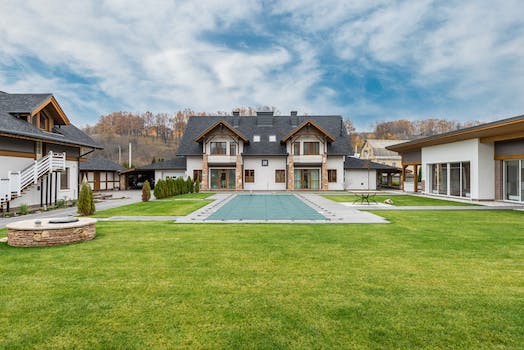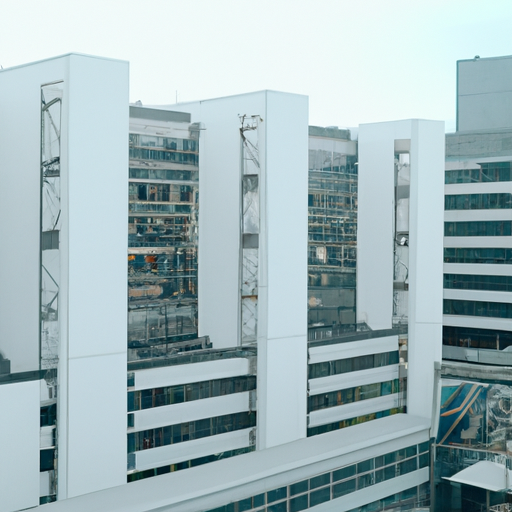Unraveling the Intricacies of Contemporary Architectural Marvels
Exploring the Beauty of Modern Complex Designs
The world of architecture has come a long way since the days of simple structures and basic designs. Today, architects and designers are pushing the boundaries of what is possible, creating complex and intricate buildings that are not only functional but also visually stunning. These contemporary architectural marvels are a testament to the creativity and innovation of modern designers, who are constantly seeking new ways to challenge the status quo and redefine the limits of their craft.
One of the most striking aspects of modern complex designs is the way they often incorporate a variety of materials and textures. This can be seen in the use of glass, steel, concrete, and wood, which are combined in unique and unexpected ways to create visually arresting structures. The juxtaposition of these materials not only adds visual interest but also serves a practical purpose, as each material has its own unique properties and strengths. For example, glass can be used to create a sense of lightness and transparency, while steel and concrete provide strength and stability.
Another key feature of contemporary architectural marvels is their innovative use of space. Architects are increasingly looking for ways to maximize the functionality of a building while minimizing its footprint, often through the use of clever design techniques and cutting-edge technology. This can be seen in the growing popularity of vertical gardens, which allow for green spaces to be incorporated into the design of a building without taking up valuable floor space. Similarly, the use of modular construction techniques allows for buildings to be easily adapted and reconfigured to meet changing needs and requirements.
The incorporation of sustainable design principles is also a hallmark of modern complex designs. As concerns about climate change and environmental degradation continue to grow, architects are increasingly looking for ways to minimize the impact of their buildings on the environment. This can be seen in the use of energy-efficient materials and technologies, as well as the incorporation of green spaces and natural elements into the design of a building. By prioritizing sustainability, architects are not only creating visually stunning structures but also helping to ensure the long-term health of our planet.
One of the most exciting aspects of contemporary architectural marvels is the way they often blur the lines between art and architecture. Many modern buildings are designed with a strong emphasis on aesthetics, incorporating bold shapes, vibrant colors, and striking patterns that make them stand out from their surroundings. This focus on visual appeal is not just about creating beautiful buildings, but also about challenging our perceptions of what architecture can and should be. By pushing the boundaries of traditional design, architects are encouraging us to see the built environment in a new and exciting way.
In conclusion, the beauty of modern complex designs lies in their ability to combine form and function in innovative and unexpected ways. By incorporating a variety of materials, maximizing the use of space, prioritizing sustainability, and blurring the lines between art and architecture, contemporary designers are creating architectural marvels that are not only visually stunning but also serve as a testament to the creativity and ingenuity of the human spirit. As we continue to explore the intricacies of these contemporary masterpieces, we can only marvel at the boundless potential of modern architecture and eagerly anticipate the groundbreaking designs that are yet to come.
The Art of Blending Functionality and Aesthetics in Modern Design

Exploring the Beauty of Modern Complex Designs
The art of blending functionality and aesthetics in modern design is a delicate balance that requires a deep understanding of both form and function. This intricate dance between the two elements has given rise to some of the most breathtaking and innovative designs in recent years. As we delve into the world of modern complex designs, we will discover how designers are pushing the boundaries of what is possible, creating spaces and objects that are not only visually stunning but also serve a practical purpose.
One of the key aspects of modern design is the emphasis on simplicity and minimalism. This design philosophy is rooted in the belief that less is more, and that by stripping away unnecessary elements, we can create spaces and objects that are more efficient, functional, and aesthetically pleasing. However, this does not mean that modern design is devoid of complexity. On the contrary, many modern designs are incredibly intricate and complex, with a focus on innovative materials, cutting-edge technology, and creative problem-solving.
One of the most striking examples of modern complex design can be found in the world of architecture. Architects are constantly pushing the boundaries of what is possible, creating structures that are not only visually stunning but also serve a practical purpose. One such example is the Harbin Opera House in China, designed by MAD Architects. This stunning structure features a sinuous, organic form that is both visually arresting and functional. The building’s unique shape allows it to blend seamlessly with its natural surroundings, while also providing optimal acoustics for performances.
Another example of modern complex design can be found in the realm of product design. Designers are constantly seeking new ways to improve the functionality and aesthetics of everyday objects, often through the use of innovative materials and technology. One such example is the Dyson Supersonic hair dryer, which features a sleek, minimalist design that is both visually appealing and highly functional. The hair dryer’s unique design allows it to be lightweight and easy to handle, while also providing a powerful and efficient drying experience.
In addition to architecture and product design, modern complex design can also be found in the world of fashion. Designers are increasingly experimenting with innovative materials, techniques, and technologies to create garments that are both visually stunning and functional. One such example is the work of fashion designer Iris van Herpen, who is known for her intricate, sculptural designs that often incorporate cutting-edge technology and materials. Van Herpen’s creations are not only visually striking but also serve a practical purpose, as they often incorporate elements of sustainability and functionality.
The art of blending functionality and aesthetics in modern design is not limited to physical objects and spaces. Digital design, such as website and app design, also requires a delicate balance between form and function. Designers must create interfaces that are visually appealing and easy to navigate while also providing users with the information and tools they need to accomplish their goals. This often involves the use of complex design elements, such as interactive graphics, animations, and responsive design, to create a seamless and engaging user experience.
In conclusion, the beauty of modern complex design lies in the artful balance between form and function. By pushing the boundaries of what is possible, designers are creating spaces, objects, and experiences that are not only visually stunning but also serve a practical purpose. As we continue to explore the world of modern design, we can expect to see even more innovative and breathtaking examples of this delicate dance between aesthetics and functionality.
Navigating the World of Abstract and Geometric Patterns in Contemporary Art
Exploring the Beauty of Modern Complex Designs
The world of contemporary art is a vast and diverse landscape, filled with a myriad of styles, techniques, and themes. One particularly captivating area of this artistic realm is the exploration of abstract and geometric patterns. These designs, which often feature intricate arrangements of shapes, lines, and colors, have become increasingly popular in recent years, as artists and designers alike seek to push the boundaries of visual expression. This article delves into the fascinating world of modern complex designs, examining the allure of abstract and geometric patterns and their significance in contemporary art.
At the heart of abstract and geometric patterns lies the concept of visual complexity. This idea refers to the intricate and often perplexing nature of certain images, which can be both aesthetically pleasing and intellectually stimulating. In the context of contemporary art, visual complexity is often achieved through the use of abstract and geometric designs, which can be found in a wide range of mediums, from paintings and sculptures to digital art and architectural installations.
One of the primary reasons for the growing popularity of abstract and geometric patterns in contemporary art is their ability to evoke a sense of wonder and curiosity in the viewer. These designs often feature a high degree of intricacy, with numerous elements and layers that can be difficult to fully comprehend at first glance. This complexity can be both visually arresting and mentally engaging, as viewers are drawn into the artwork and encouraged to explore its various components in greater detail.
In addition to their visual appeal, abstract and geometric patterns also hold a certain philosophical allure. These designs often eschew traditional representations of reality, instead opting for a more conceptual approach that seeks to challenge the viewer’s preconceived notions of the world around them. This can be particularly powerful in the context of contemporary art, as it encourages viewers to question their own perceptions and consider alternative ways of understanding the world.
Another key aspect of abstract and geometric patterns in contemporary art is their versatility. These designs can be adapted to a wide range of artistic styles and mediums, making them an ideal choice for artists looking to experiment with new techniques and ideas. For example, abstract and geometric patterns can be found in the work of painters, sculptors, and digital artists alike, each of whom brings their own unique perspective and interpretation to the table.
Furthermore, the use of abstract and geometric patterns in contemporary art can also serve as a means of exploring cultural and historical themes. Many artists draw inspiration from the rich history of geometric design, which can be traced back to ancient civilizations such as the Greeks, Romans, and Egyptians. By incorporating these historical influences into their work, contemporary artists are able to create a dialogue between the past and present, exploring the ways in which these timeless designs continue to resonate with modern audiences.
In conclusion, the beauty of modern complex designs lies in their ability to captivate and engage viewers on multiple levels. Abstract and geometric patterns offer a unique combination of visual complexity and philosophical depth, making them an ideal choice for artists looking to push the boundaries of contemporary art. As the popularity of these designs continues to grow, it is clear that they will remain an important and influential force in the world of art for years to come. So, the next time you encounter a piece of contemporary art featuring abstract and geometric patterns, take a moment to appreciate the intricate beauty of these designs and consider the myriad of ideas and themes they represent.
Q&A
Question 1: What are the key elements of modern complex designs?
Answer: The key elements of modern complex designs include minimalism, functionality, geometric shapes, bold colors, innovative materials, and a blend of technology and art.
Question 2: How do modern complex designs impact user experience?
Answer: Modern complex designs enhance user experience by providing visually appealing aesthetics, improved functionality, and intuitive interfaces that cater to the needs and preferences of users.
Question 3: What are some examples of modern complex designs in architecture?
Answer: Examples of modern complex designs in architecture include the Guggenheim Museum in Bilbao, the Louvre Pyramid in Paris, and the Beijing National Stadium (Bird’s Nest) in China.
Conclusion
In conclusion, modern complex designs showcase the beauty of innovation, creativity, and technological advancements in various fields. These intricate designs not only captivate the audience with their aesthetic appeal but also demonstrate the limitless potential of human imagination and skill. As we continue to explore and embrace modern complex designs, we can expect to witness a fascinating fusion of art, science, and technology, ultimately enriching our experiences and understanding of the world around us.


